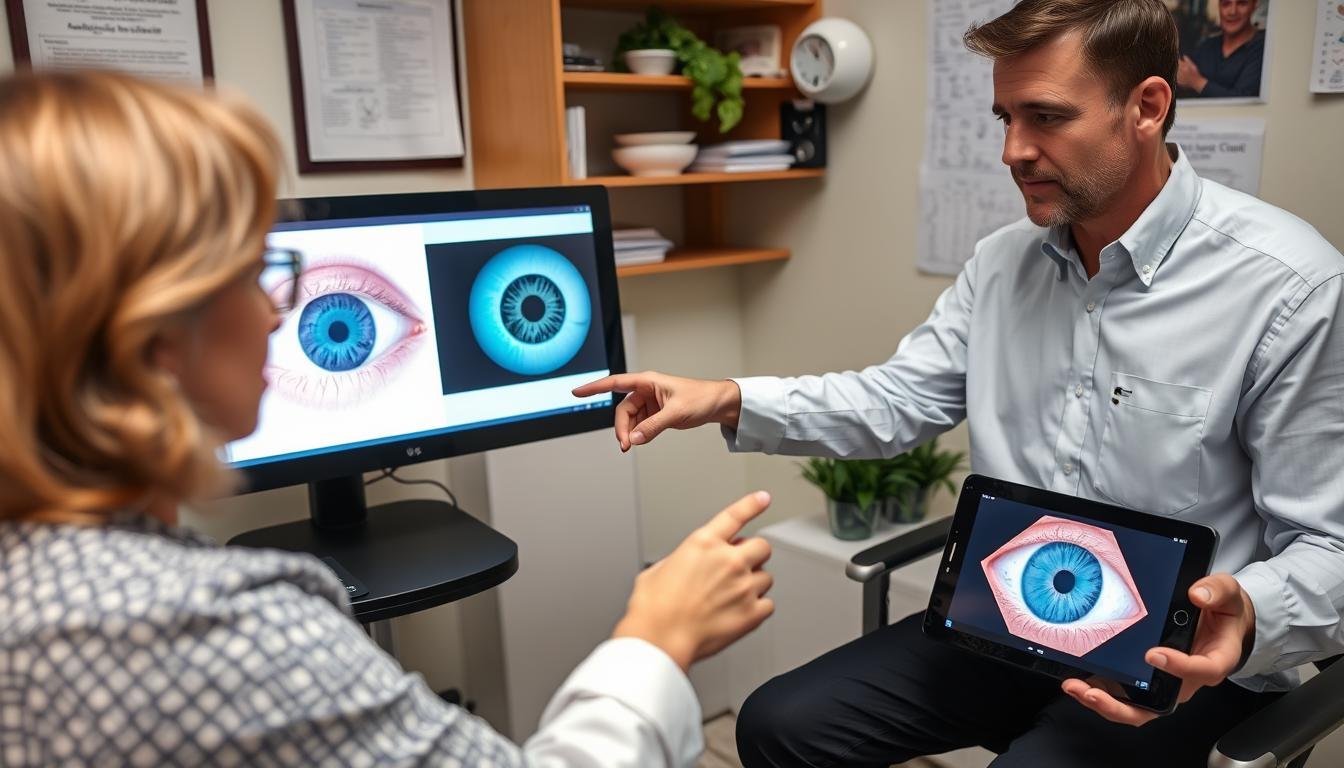The ancient practice of iridology—analyzing the iris of the eye to detect potential health issues—has gained renewed interest in recent years. If you’re considering visiting an iridolog for the first time, you likely have questions about what the experience entails. This comprehensive guide will walk you through the entire process, from preparation to follow-up, so you can approach your first iridolog consultation with confidence and clarity.
Un iridolog examining the intricate patterns of a patient’s iris
Ce este un Iridolog? Roles and Techniques
Un iridolog is a practitioner who studies the patterns, colors, and other characteristics of the iris—the colored part of your eye—to gather information about your overall health. The practice is based on the theory that the iris connects to every organ and tissue via the nervous system and displays changes in these tissues through distinctive signs in the iris.
The fundamental principle behind iridology is that the iris can reveal information about:
- Inflammation levels in different body systems
- Acumularea de toxine în organe specifice
- Nutritional deficiencies
- Stress patterns and their physical manifestations
- Constitutional strengths and weaknesses
Unlike conventional medical doctors, Iridologi don’t claim to diagnose specific diseases. Instead, they identify areas of potential concern and overall constitutional patterns that may indicate imbalances in your body.



An iridology chart mapping iris zones to corresponding body systems
Training and Certification of an Iridolog
The training background of Iridologi can vary significantly. Some practitioners come from conventional healthcare backgrounds such as nursing or naturopathy before specializing in iridology, while others focus exclusively on this practice.
Common credentials to look for include:
- Certification from recognized iridology associations
- Completion of formal iridology training programs
- Additional qualifications in complementary health fields
- Continuing education in the latest iridology research
When selecting an iridolog, it’s advisable to inquire about their specific training, experience, and approach to practice.
Ready to Discover What Your Eyes Reveal?
Book your first consultation with a certified iridolog and gain insights into your body’s health patterns.
Programează o consultație
Preparing for Your First Iridolog Visit
To get the most from your first iridolog consultation, proper preparation is key. This ensures the practitioner can gather accurate information and provide the most relevant insights about your health.

Preparing your health history before meeting with an iridolog
Before Your Appointment
- Avoid wearing contact lenses for at least 24 hours before your visit
- Skip eye makeup on the day of your appointment
- Bring a list of current medications and supplements
- Compile your medical history, including chronic conditions
- Note any specific health concerns you’d like to address
- Avoid alcohol consumption for 24-48 hours before your visit
- Stay well-hydrated in the days leading up to your appointment
Questions to Ask Your Iridolog
- What is your training and certification in iridology?
- How many years have you been practicing?
- What can and can’t be determined through iris analysis?
- How do you integrate findings with conventional healthcare?
- What follow-up is recommended after the initial consultation?
- Do you provide written reports of your findings?
- What types of recommendations might you make based on findings?
Important: While iridology can provide interesting insights about your health patterns, it should complement rather than replace conventional medical care. Always consult with your primary healthcare provider about any serious health concerns.
Step-by-Step: The Iridolog Consultation Process
Understanding what happens during an iridolog consultation can help ease any anxiety and allow you to participate more actively in the process. Here’s what typically occurs during your first visit:

Un iridolog reviewing iris analysis findings with a patient
1. Initial Interview
Your consultation begins with a comprehensive health history discussion. The iridolog will ask about your current health concerns, medical history, lifestyle habits, and family health patterns. This conversation provides context for the iris analysis that follows.
2. Iris Examination
The iridolog will examine both of your irises using specialized equipment. They may use a magnifying lens, slit lamp, or digital iriscope to capture detailed images. The examination is non-invasive and painless, typically taking 15-30 minutes.
3. Analysis and Mapping
Using iridology charts, the practitioner maps your iris patterns to corresponding body systems. They look for color variations, structural features, and other signs that may indicate constitutional strengths and weaknesses in different areas of your body.
4. Findings Discussion
After the analysis, the iridolog will discuss their observations with you. They’ll explain what patterns they’ve identified and what these may suggest about your health. This is an interactive conversation where you can ask questions about the findings.
5. Recommendations
Based on their analysis, the iridolog may suggest dietary changes, specific supplements, lifestyle modifications, or stress management techniques. These recommendations are typically tailored to address the patterns observed in your iris.
6. Follow-Up Plan
Your iridolog will outline a suggested follow-up schedule. This may include future iris examinations to track changes, consultations to assess progress, or referrals to other health practitioners if needed.
A typical first consultation lasts between 60-90 minutes, allowing sufficient time for a thorough assessment and discussion. Follow-up visits are usually shorter, focusing on progress and any changes observed in the iris.
Experience the Insights of Iridology
Discover what your iris reveals about your health patterns with a professional consultation.
Book Your First Session
Case Studies: Real-Life Iridolog Consultations
To better understand the practical applications of iridology, let’s explore how iridolog consultations have helped individuals identify and address various health concerns. These anonymized case studies illustrate the typical experience and outcomes.

Before and after iris photographs following an iridologist’s recommendations
Case Study: Sarah’s Digestive Issues
Initial Consultation: Sarah, 42, sought an iridolog consultation after experiencing chronic digestive discomfort that conventional testing hadn’t fully explained. The iridolog observed specific markings in the digestive zone of her iris that suggested inflammation and potential food sensitivities.
Recomandări: The iridolog suggested an elimination diet focusing on removing common inflammatory foods, adding specific digestive herbs, and implementing stress reduction techniques.
Rezultat: After three months following these recommendations, Sarah reported significant improvement in her symptoms. A follow-up iris examination showed subtle changes in the digestive zone markings, which the iridolog interpreted as reduced inflammation.
Case Study: Michael’s Energy Concerns
Initial Consultation: Michael, 55, visited an iridolog complaining of persistent fatigue despite normal blood work. The iris analysis revealed patterns suggesting adrenal stress and potential mineral deficiencies, particularly in the zones corresponding to the endocrine system.
Recomandări: The iridolog recommended specific adaptogenic herbs, targeted mineral supplementation, and modifications to Michael’s sleep routine and exercise patterns.
Rezultat: Over six months, Michael gradually experienced improved energy levels and stress resilience. His follow-up iris examination showed subtle changes that the iridolog associated with improved adrenal function.

Un iridolog explaining iris markings using reference charts
“While my conventional doctor found nothing wrong in my tests, my iridolog identified patterns that led to dietary changes that significantly improved my quality of life. I appreciate having both perspectives as part of my health journey.”
— Client testimonial from a first-time iridology consultation
FAQs About Seeing an Iridolog
Many people have questions about what to expect when visiting an iridolog for the first time. Here are answers to the most common inquiries:

Un iridolog addressing common questions during a consultation
How long does an iridolog consultation typically take?
A first-time consultation with an iridolog usually lasts between 60-90 minutes. This includes time for your health history interview, the iris examination itself, and a discussion of findings and recommendations. Follow-up visits are typically shorter, ranging from 30-45 minutes.
Is an iridolog examination painful or uncomfortable?
No, an iridology examination is completely non-invasive and painless. The iridolog simply observes your iris using specialized lighting and magnification. There’s no touching of the eye itself, and no drops or other substances are applied to the eye during a standard examination.
Can an iridolog diagnose specific diseases?
No, Iridologi do not diagnose specific diseases. Instead, they identify patterns and signs in the iris that may indicate constitutional strengths and weaknesses, inflammation, or stress in various body systems. These observations can complement, but should not replace, conventional medical diagnosis.
How much does an iridolog consultation cost?
Fees vary widely depending on the practitioner’s experience, location, and the depth of the consultation. Initial consultations typically range from $75-$200, with follow-up visits costing less. Many Iridologi offer package options for ongoing care. Insurance coverage is limited, so it’s best to check with your provider.
How should I prepare for my appointment with an iridolog?
For the best results, avoid wearing contact lenses for 24 hours before your appointment, skip eye makeup on the day of your visit, and bring a list of your current medications, supplements, and health concerns. It’s also helpful to compile a basic medical history to share with your iridolog.
Is there scientific evidence supporting iridology?
The scientific community has mixed views on iridology. While some studies have not found evidence supporting its diagnostic capabilities, proponents point to clinical experience and case studies showing beneficial outcomes. It’s best viewed as a complementary approach rather than a replacement for conventional medical care.
How often should I see an iridolog?
After your initial consultation, follow-up visits are typically recommended at 3-6 month intervals, depending on your specific health concerns and the recommendations provided. This allows sufficient time to implement suggested changes and for potential shifts in iris patterns to become visible.
Can children visit an iridolog?
Yes, many Iridologi work with children. The examination process is gentle and non-invasive, making it suitable for younger patients. For very young children, the practitioner may use modified techniques to make the experience comfortable and engaging.
What types of recommendations might an iridolog make?
Based on their observations, an iridolog might recommend dietary modifications, specific herbal or nutritional supplements, lifestyle changes, stress management techniques, or referrals to other health practitioners. Recommendations are typically tailored to address the specific patterns observed in your iris.
Should I tell my regular doctor about my visit to an iridolog?
Yes, it’s advisable to keep all your healthcare providers informed about the different approaches you’re exploring. This promotes integrated care and ensures that any recommendations from your iridolog can be considered alongside your conventional medical treatment plan.
Îmbrățișând ideile Iridolog Consultations
Your first visit to an iridolog can be an enlightening experience that offers a unique perspective on your health. While iridology should complement rather than replace conventional medical care, many find value in the holistic insights it provides.
By understanding what to expect during your consultation, preparing appropriately, and approaching the experience with an open mind, you can maximize the potential benefits of this fascinating practice. Whether you’re seeking to address specific health concerns or simply curious about what your eyes might reveal, an iridolog consultation offers a window into the intricate connections between your iris patterns and overall wellbeing.
Begin Your Iridology Journey Today
Your eyes may hold valuable insights about your health patterns. Schedule your first consultation with a certified iridolog and discover what your iris reveals.
Book Your Consultation Now











